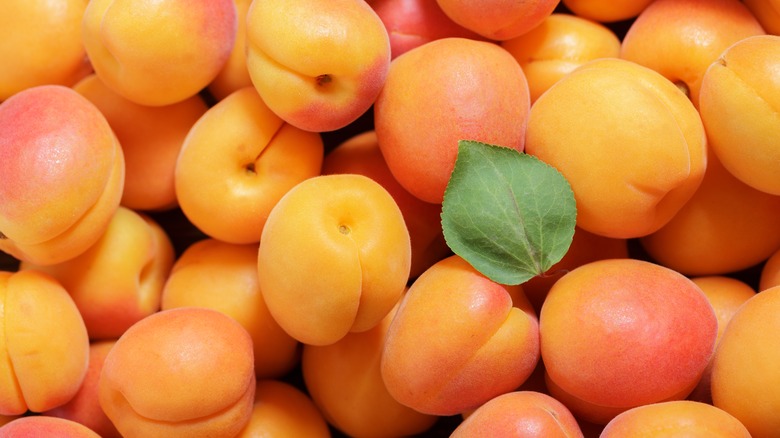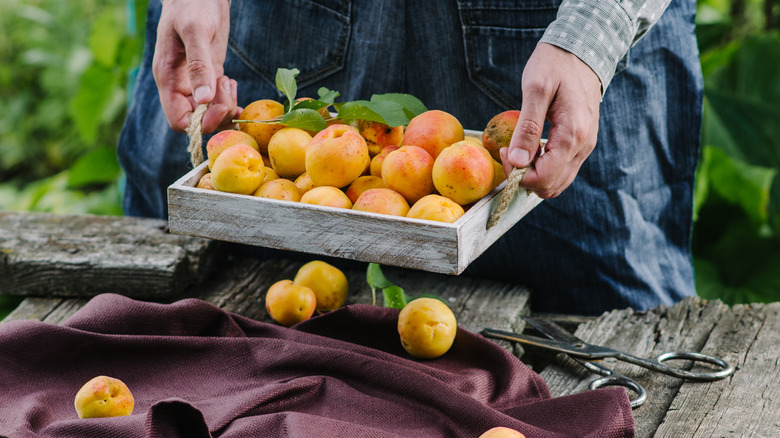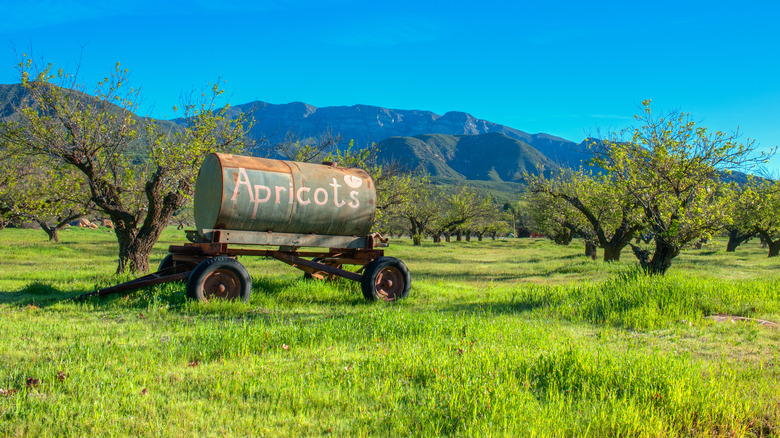Which State Produces The Most Apricots In The US?
Although the U.S. is not the top apricot-producing country in the world, it is still a notable grower of the fruit. Per the Agricultural Marketing Resource Center, thousands of apricot farms nationwide exist. $34 million worth of apricots (33,400 tons) was produced in the U.S. in 2020. $10 million of that was thanks to processed apricots, while the $24 million was fresh. The fresh ones only account for about 40% of U.S. apricot sales, but the prices involved are higher, so it generates much more profit. The U.S. also grows enough apricots that it can export to foreign countries like Canada, Mexico, and Japan.
The sweet fruit can be had fresh, canned, cooked, dried, jammed, or as a flavoring for your cocktail, according to the Encyclopedia Britannica. Aside from sugar, apricots deliver lots of vitamin A to the consumer, as well as iron in dry form. Their "stone" pits contain sweet seeds that can be eaten if roasted (the seeds are poisonous prior to being roasted). Apricots can also be used to create hybrids, as the Ag M.R.C. explains, since they are similar to plums. As such, there exist apriums (¾ apricot, ¼ plum), plumcots (½ apricot, ½ plum), and pluots (¼ apricot, ¾ plum). While a lot of growing and eating of apricots happens in the U.S., the fruit is not native to its lands.
History of apricots
Apricots originate from Western China, where they were discovered over three millennia ago, then domesticated, according to SF Gate. Eventually, the fruit traveled west to the Middle East, where it became very popular. The fruit's scientific name (Prunus armeniaca) even has etymological connections to ancient Armenia, per Encyclopedia Britannica. In the early 1700s, Spanish missionaries were thought to have brought fruit to the U.S. Fast forward, and apricots are now grown on every continent except Antarctica, with Middle Eastern countries like Turkey and Iran being the top producers of apricots in the entire world (via Agricultural Marketing Resource Center).
As explained by the Fruit Guys, there were thousands of apricot farmers in the U.S. by the early 20th century. Up until WWII ended, the area of the San Francisco Bay in California was an agrarian stone-fruit basket responsible for growing many apricots. Once the second Great War drew to a close, though, that all ended, and apricot growth moved elsewhere while San Fran gave way to urbanization. That was three-quarters of a century ago. So, where have U.S. apricots grown since then?
California grows the most apricots
California is the top apricot-producing state in the U.S., per Agricultural Marketing Resource Center. As noted by the Fruit Guys, apricot production moved from the San Francisco Bay area to the San Joaquin Valley, another locale in the Golden State after WWII. The University of California also mentions Contra Costa, Merced, San Benito, and Stanislaus counties. Three-quarters of all U.S. apricots are grown in California these days, which are primarily done in the state's dry and arid valleys, according to SF Gate. That's because their desert climates have long, warm, sunny days followed by cool nights, which is ideal for apricot growth. It also gives them the wintry chills they need to bud, yet the desert is unlikely to provide a harmful spring frost. The state's hot and dry summers also reduce pest and disease-related risk factors.
Historically, U.S. production of apricots wasn't successful until the fruit was brought to California from Virginia, per the University of California. Meanwhile, the cooler (temperature) state of Washington accounts for nearly 25% of U.S. apricots, and a few other states — namely Utah — contribute a bit here and there, as well (via Ag M.R.C.). Apricot season in California runs from mid-May to July, Washington's season runs from late June to early August, and Utah's is from early June to mid-August. Whether they come from California, Washington, or Utah, apricots are refreshingly sweet but take a lot to grow.
Cultivation and consumption of apricots
Apricots grow on a fruit tree belonging to the rose family, one which fairs well in temperate zones, per Encyclopedia Britannica. Such trees are sensitive to late freezes. On the other hand, they can withstand drought with great endurance. The ideal soil is well-drained loam of sand or silt that's neither toxic nor saline (as noted by the University of California and Agricultural Marketing Resource Center). Irrigation — drip or flood style — is essential for the survival of these trees. Apricot plants also need lots of sun, according to SF Gate.
The result is a sweet and tart-tasting fruit with soft and velvety skin, ranging from pale yellow to deep orange (via Spruce Eats). Unfortunately, apricots spoil easily, which is why they're so often preserved. Farmers must pick fresh ones before they're fully ripe to reduce the risk of damage during transportation. On the other hand, canned apricots keep quite well, so they can be picked when completely matured. According to Specialty Produce, commercial types of apricot include the Blenheim, Moorpark, Royal Rosa, Sungold, and Autum Royal.
Apricots can be explicitly incorporated into dressings, sauces, and desserts like bread, cakes, pastries, scones, and tarts. They also pair well with savory items, such as pork and poultry. Additionally, apricots are notably good for your eye, gut, liver, and skin health, per Healthline. No wonder the Golden State grows so many of them!



